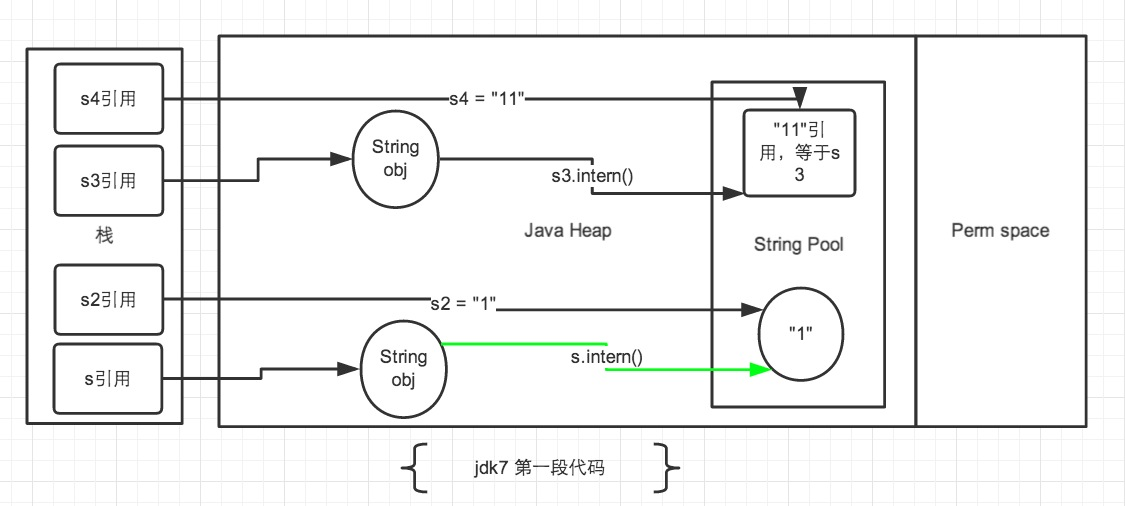intern()方法用于将字符串对象加入常量池中。
public native String intern();
intern()方法返回的是一个常量池中的String对象(即常量池中某个String对象的引用)。
String s = new String("1"); s.intern();
s是一个位于堆中的String对象,其字符串值为 "1" , 调用s的intern()方法,可在常量池中创建一个字符串值与s相同的String对象。
创建过程为:
首先查找常量池中是否已存在值为 "1" 的String对象,若存在则返回该对象。
若不存在,在JDK1.6及之前,会在常量池中创建一个新的值为 "1" 的String对象,并返回该对象。
在JDK1.7及之后,会将s的引用添加至常量池中,堆中的String对象s间接的成为了常量池中的一员,此时返回的是对象s。
示例:
public static void main(String[] args) { String s = new String("1"); s.intern(); String s2 = "1"; System.out.println(s == s2); String s3 = new String("1") + new String("1"); s3.intern(); String s4 = "11"; System.out.println(s3 == s4); }
jdk1.6下输出结果为 false false
jdk1.7下输出结果为 false true
jdk1.6下解释:
jdk6中的常量池是放在 Perm 区中的,Perm区和正常的 JAVA Heap 区域是完全分开的。使用引号声明的字符串都是会直接在字符串常量池中生成,而 new 出来的 String 对象是放在 JAVA Heap 区域。
String s = new String("1"); 创建了两个String对象,一个位于堆中即是s,一个位于常量池中,值为"1"。
String s2 = "1"; 由于常量池中已经存在值为"1"的String对象,所以s2指向的是常量池中的String对象。
所以s == s2 结果为false,s与s2指向的并不是同一个对象。
String s3 = new String("1") + new String("1"); 在堆中创建了一个值为"11"的String对象即是s3。
s3.intern();由于常量池中没有值为"11"的String对象,所以在池中创建了一个。
String s4 = "11";常量池中已经存在值为"11"的String对象,所以s4指向了常量池中的String对象。
所以s3 == s4 结果为false,s3与s4指向的并不是同一个对象。

jdk1.7下解释:
String s = new String("1"); s.intern(); String s2 = "1"; System.out.println(s == s2); String s3 = new String("1") + new String("1"); s3.intern(); String s4 = "11"; System.out.println(s3 == s4); System.out.println(s3.intern() == s3);
在 jdk7 及以后的版本中,字符串常量池从Perm区移到Java Heap区域。
String s = new String("1"); 创建了两个String对象,一个位于堆中即是s,一个位于常量池中,值为"1"。
String s2 = "1"; 由于常量池中已经存在值为"1"的String对象,所以s2指向的是常量池中的String对象。
所以s == s2 结果为false,s与s2指向的并不是同一个对象。
String s3 = new String("1") + new String("1"); 在堆中创建了一个值为"11"的String对象即是s3。
s3.intern();由于常量池中没有值为"11"的String对象,所以在常量池中添加对象s3的引用。
String s4 = "11";常量池中已经存在值为"11"的String对象(这个对象实际是s3),所以s4指向了s3指向的String对象。
所以s3 == s4 结果为true,s3与s4指向的是同一个对象,都是堆中值为 "11" 的String对象。

其它示例:
// 在堆中创建了一个值为"11"的String对象即是s3 String s3 = new String("1") + new String("1"); // 常量池中没有值为"11"的String对象 // 所以在池中创建了一个新的String对象 String s4 = "11"; // 常量池中存在值为"11"的String对象,即是s4指向的对象 // intern返回s4指向的对象 s3.intern(); // intern返回的是s4指向的对象 System.out.println(s3.intern() == s4); // true // s3指向的是堆中的对象 // s4指向的是常量池中新建的对象 // 故结果为false System.out.println(s3 == s4); // false
String str1 = new String("Hello") + new String("World"); System.out.println(str1.intern() == str1); // true String str2 = "HelloWorld"; System.out.println(str1 == str2); // true
String str2 = "HelloWorld"; String str1 = new String("Hello") + new String("World"); System.out.println(str1.intern() == str1); // false System.out.println(str1 == str2); // false